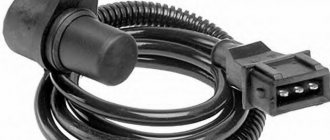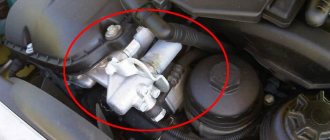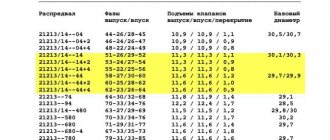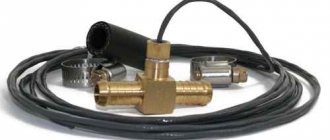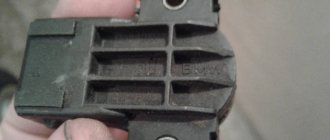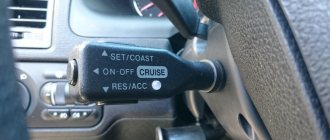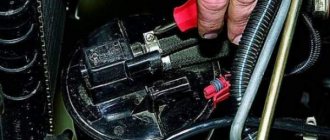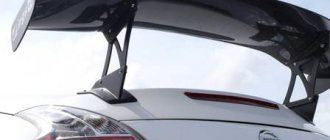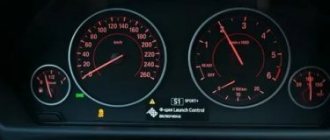The camshaft position sensor (another name is the phase sensor, the English abbreviation is CMP) is designed to determine the angular position of the camshaft in a certain period of time. The information generated by the sensor is needed to control the injection and ignition system . In particular, so that injection occurs only in one cylinder, which is located at the top “dead” point.
1 - Toothed disk of the camshaft pulse sensor, 2 - Hall sensor
The camshaft Hall sensor transmits cylinder recognition and/or camshaft speed information to the control unit. It is also used for injection systems with sequential injection mode and/or for distributorless ignition systems with single-spark ignition coils.
The sensor probes pins, teeth, pulse sensor teeth, or sensor disks mounted on the camshaft or camshaft drive.
Where is the camshaft sensor (DPRV) located?
The location is different on different engines; basically, the sensor that determines the angular position of the camshaft is mounted next to the cylinder head. Also, depending on the make and model of the car, it can be located either on the right or on the left. The sensor is small in size, so you need to look for it. It can also be in protected parts of the electrical wiring. The DPRV can also be mounted on the rear of the engine. And some car manufacturers, such as General Motors, have special compartments for such a sensor.
How does the camshaft sensor work?
Based on the principle of operation, DPRVs are classified into 3 types:
- magnetic dprv;
- optical dprv;
- dprv Hall.
A magnetic or induction camshaft position sensor works because a metal tooth is constantly moving in a magnetic field. This sensor has two outputs.
The operating principle of an optical sensor works by emitting a beam of light from a source, which is tracked and recorded by reception and interruption by a photocell.
A Hall effect sensor monitors changes in the magnetic field around it. Hall-effect DPRVs have three outputs. The Hall effect is also called Hall voltage.
The most rarely used camshaft position sensors are optical ones. Don’t be surprised if the car has more than one or even two DPRV sensors, this is also possible.
What have you heard about the safety of the SRS system? It consists of impact sensors, actuators and an SRS control unit.
The principle of operation of a Hall sensor is that it detects changes in voltage that crosses its magnetic field. The sensor structure contains a piston magnet and a semiconductor element, which records voltage changes. If the magnetic field does not change, then the sensor will not detect any changes. The magnetic field will only change if there is any metallic element in that environment. The notches or teeth on the camshaft are precisely metal elements that change the magnetic field.
As was already mentioned above, the DPRV is also called a phase sensor. This name comes from the fact that the sensor records the cylindrical phases of intake and exhaust.
Operating principle of the sensor
General view of the camshaft sensor
The camshaft sensor or phase sensor is a part of the main power unit of the car, which is responsible for reading information about the location of the camshaft and is also involved in adjusting the ignition angle.
This meter is similar in principle to a Hall sensor .
We recommend: Purpose and principle of operation of the main automatic transmission sensors
Reading occurs using a special camshaft gear that has no teeth. The missing elements are located in such a way that when this gap hits the sensor, the first piston is at the dead center, at the top or bottom.
Phase sensor operation diagram
A signal is triggered and transmitted to the engine's electronic control unit when the sensor hits the missing teeth. In turn, depending on the received indicator, the ECU adjusts the ignition angle. Thanks to the installation of such a system, Samara-2 engines have become more efficient and popular.
Location of the sensor under the hood of the VAZ-2114
The camshaft sensor on the VAZ-2114 is located near the air filter, at a very close distance from the cylinder head. This meter location is almost always standard for other cars in the injection group.
Camshaft sensor location
The main reasons for sensor failure
Before proceeding directly to the diagnostic process, it is necessary to find out the causes of the malfunction of the VAZ-2114 phase sensor.
So, let's move directly to the most direct and indirect indicators:
Electrical circuit of the sensor
- Check Engine on the dashboard indicates that a malfunction has occurred. In this case, the engine starts without waiting for a response from the camshaft sensor, and the ignition system works based on the latest indicators.
- Increased consumption of the fuel mixture can also serve as an indirect indicator of a malfunction of the air flow control valve.
- The car begins to lose power and dynamics as a whole.
The combination of these reasons can serve as an indirect indicator of a malfunction of the camshaft sensor.
What are the reasons for the malfunction of the DPRV?
If the camshaft position sensor fails, the injector will fire for each crankshaft revolution, that is, twice as often.
Symptoms or signs of a broken sensor:
- Fuel consumption increases significantly.
- The engine operates asynchronously while driving, that is, it jerks while moving, drives jerkily, and loses speed. The engine may stall as if it has run out of gas. Also, sometimes the car cannot reach a high speed, more than 60 km/h. Cars are equipped with speed sensors. Find out what causes problems with their operation and how to check speed sensors.
- On certain brands and models of cars, if the DPRV is faulty, the gearbox may stall. The way out of a locked gearbox is to restart the engine. If this happens constantly, then you have definitely exited the CMP operating mode.
- When diagnosing yourself with a scanner, malfunctions may occur.
- The spark may also disappear and the engine may not start.
- The check light comes on at idle, but goes out at high speeds.
Such reasons for a non-working sensor are shown on the instrument panel with the corresponding icons. When the DPRV (SMR) is not working, the control unit will record the incorrect operating mode and issue a specific error code. To decipher error codes, you can download the application to your phone or tablet and find out what exactly this error code means.
Here are the most frequently encountered errors:
- P0365 means there is no signal in the camshaft position sensor circuit.
- P0344 warns that the signal supplied by the sensor is weak and intermittent.
- P0343 The signal supplied by the CMP sensor is too high.
- P0342 says the DPRV single level is too low.
- P0341 The valve timing does not correspond to the state of proper engine operation.
- P0340 There is no signal from the sensor at all.
- P0300 stands for a violation of ignition cycles in the ignition system (ignition is often skipped).
Factors influencing the occurrence of reasons indicating a non-working condition of the camshaft position sensor:
- Signal wires are not connected to the sensor.
- There is moisture in the sensor connection.
- The signal wire touches ground (some metal object in the car).
- The signal wire is open and torn off.
- The signal wire closes to the on-board network.
- The sensor insulation is broken, the shielding shell or harness is broken.
- The sensor power cord is torn or damaged.
- The power cables are not connected correctly.
- The high-voltage wires of the ignition circuit are faulty.
- The engine control unit is not working correctly.
- The gap between the sensor and the mark is not in accordance with the norm (the gap is too large or too small).
- The camshaft gear “beats”, that is, it has an exceeded standard of end runout.
- There are metal shavings on the DPRV body.
Instructions for checking and replacing
If the above methods failed to normalize its condition, then this part must be replaced. There is nothing complicated in replacing, as well as in checking, since their camshaft is mounted without adjusting the gap. Thanks to this function, you can avoid mistakes when installing a new device. If the gap is adjusted, certain standards must be observed.
If you are not sure that replacing the camshaft sensor yourself will be successful, take it to a special service center. There the replacement is made using an oscilloscope. When starting the oscilloscope, stability of data reading is observed at different engine speeds.
If you have an oscilloscope and you are confident that you can do such a procedure, do it. Just pay close attention to the changing data that the oscilloscope will show. If it shows straight stripes and there are no gaps, that's good. Because you just have to remove the old one and install a new one.
In principle, if you use this method, you need to take into account many points and features that the tester provides in order for the replacement of this camshaft part to be successful. Since, if the indicator does not work, then, logically, the engine should not work. But technology is a delicate matter, and sometimes it malfunctions. If the sensor and built-in electrical devices do not know the location, they go into an emergency state. And, being in this state for a long time, the sensor fails.
We recommend: How to add oil to the engine?
How to check the camshaft position sensor
If a problem is detected in the camshaft sensor during diagnostics, it is necessary to check the sensor for proper operation. This is done using a multimeter or voltmeter.
The check is usually carried out in the following ways:
- checking the sensor connection to all three wires (signal wire, +12 V power, “-“ power);
- if there is voltage supply and ground to the sensor, you need to start the car engine and check the pulse of the signal wire;
- checking the plug for the presence of oxides, water may have entered and the contacts have oxidized;
- checking the signal wire often reveals the problem of a non-functioning sensor, since the wire is located next to the motor and is exposed to heat;
- checking the resistance of the sensor, for this you need to set the multimeter to the 2000 Ohm position, connect it to the sensor terminals, the resistance value should be from 0.55 to 0.75 kOhm (kiloOhm);
- checking the insulation resistance of the sensor between the core and contacts of the 1st and 2nd blocks using an Ohmmeter or multimeter. The resistance value should be more than 20 MOhm (megaohm) at a voltage value of 500 Volts.
- checking with a voltmeter or multimeter in the position of measuring direct voltage.
- To do this, you need to disconnect the plug and connect the alligator clips or needles of the measuring device to the terminals on the sensor.
- Next you need to turn on the ignition.
- We connect the positive wire of the tester to the positive terminal of the sensor, the negative wire to the car body.
- The Volts value should be the same as on the battery.
Next, we connect the positive wire of the voltmeter to the negative terminal of the sensor, and the negative wire also to the ground of the car.
- The Volts value of the “mass” should be zero.
- After checking the “+” “-“ wires, connect them as expected, and pass the third wire (signal) through a multimeter. To do this, connect one needle of the tester to the signal output on the engine, and the other to the signal wire on the tester (you will have to expose the signal wire a little).
- Next, turn the ignition key and crank the starter. When the starter rotates, a properly functioning sensor should show voltage fluctuations from 0 to 5 Volts. If there is no voltage, then replace the DPRV with your own hands; to do this, you just need to disconnect the wire plug and unscrew the bolt. When installing a new sensor, do not overtighten it; the tightening torque for the camshaft sensor should be 10 Nm (Newton per meter).
Meter design and location
The operating principle of the DPRV is based on the Hall effect - the sensor reacts to the approach of a metal mass by changing the voltage on the signal wire. The design of the device is similar to another element - the crankshaft position detector. Inside the plastic case there is a coil where the 12 V on-board voltage is constantly supplied.
The meter is installed on the engine cylinder head in close proximity to the camshaft. The latter is equipped with a special plate or gear, whose rotation affects the DPRV. The work algorithm looks like this:
- After turning on the ignition and starting the engine, a 12 V supply voltage is supplied to the sensor. Through the third signal wire, the element supplies the controller with a voltage of 90–95% of the original one.
- When the protrusion on the rotating part of the camshaft passes next to the DPRV housing, the voltage at the signal contact drops to 0.2–0.4 volts, depending on the design of the device and the vehicle model.
- When the voltage drops, the electronic unit clearly “sees” the valve timing, promptly supplies the fuel mixture to the engine cylinders and directs the spark discharge to the desired spark plug.
Note. On cars with 16-valve engines, 2 sensors are installed - one for each camshaft.
When the meter is faulty, the electronics are unable to control the operation of the gas distribution mechanism. In such cases, the control unit goes into error and is guided by the signals of other meters. Spark generation and fuel supply are adjusted according to the programmed program, which affects the operation of the power unit.
We recommend: We select spark plugs Denso, NGK, Bosh, Beru, Champion by car make
